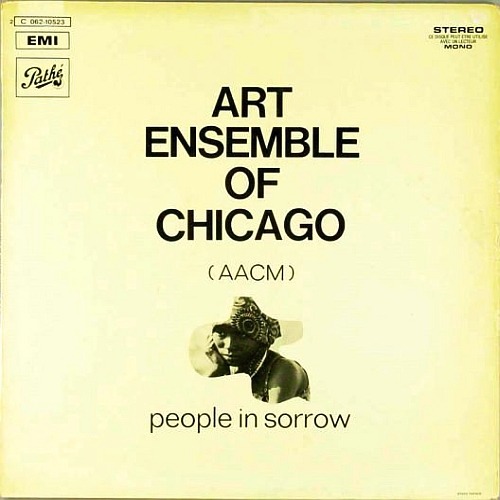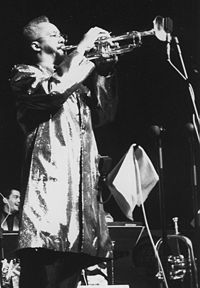An Introduction
Words: Gian Paolo Galasi
 |
| The Art Ensemble of Chicago in Nervi 1979 |
People could immerse way ahead back in the history of jazz, and that was a refreshing and exciting experience, for all those educated by the likes of
Slint,
Tortoise,
Gastr Del Sol or
Godspeed You Black Emperor! to be curious about past and present forms of music more focused on expanding structures and dealing with sound, more that previous post-modern indie-rock or grunge-existentialist generation.
Adventurous listeners (and musicians, at least the younger ones, those more interested in developing something more personal on their own) were also putting their ears on heavy psychedelia rooted in kraut-rock (
Can,
Neu!,
Popol Vuh), in that part of English progressive music formerly known as 'Canterbury rock' (
Soft Machine,
Henry Cow, that were collaborating with the South-African
The Blue Notes /
Brotherhood of Breath), and contemporary music (
John Cage,
Karlheinz Stockhausen) so to have a more complete picture of the past century perspectives on music.
The internet was also full of resources for those who wanted to go deeper with that music than
The Wire or other reviews on both sides of the Atlantic were doing on paper:
Matthew Goodheart notes on Cecil Taylor music, wide portions of socialist Frank Kofsky's writings on the 60's ideals surrounding and infusing
both John Coltrane and Malcolm X;
Perfect Sound and
Bagatellen's essays and interviews, and, more obviously, lots of files to download, listen to and share, waiting for a physical reissue to put on shelves.
Coming back on topic, for thirty-something listeners The Art Ensemble of Chicago was the more affordable experience to start with, along with the Sun Ra Arkestra. Because of the constant presence of two major works like the couple of Atlantic outputs, in which the use of percussions, their relative 'straightness' and fluidity can be considered a good hint in understanding and appreciating their theatrical attitude. It is impossible to introduce the Art Ensemble of Chicago (from now on AEC) without talking about the Association for the
Advancement of Creative Musicians (AACM).
In order to introduce the AACM, those words by Anthony Braxton can be considered an excellent syinthetic statement:
"The AACM musicians [...] not only they demonstrated a solo music, they've demonstrated ensemble music, orchestral music, music in the conventional systems, music in their own systems and their own relationship to time and rhythm; [...] People talk about the AACM as if it represented one set of values or one area of research, but it was a dynamic spectrum: no one was interested in establishing a single collective voice. It was a restructuralist school, a union of restructuralist thinkers".
 |
| Apartment Building in Chicago's "Black Belt" |
"The history of African Americans in Chicago dates back to Jean Baptiste Point du Sable’s trading activities in the 1780s.[1] Fugitive slaves and freedmen established the city’s first black community in the 1840s. By the late 19th c., the first black had been elected to office.
The Great Migrations from 1910 to 1960 brought hundreds of thousands of blacks from the South to Chicago, where they became an urban population. They created churches, community organizations, important businesses, and great music and literature. African Americans of all classes built community on the South Side of Chicago for decades before the Civil Rights Movement. Their goal was to build a community where blacks could pursue life with the same rights as whites." (from Wikipedia)
The
'Black Belt', which was the city's ghetto (even if socially well notched) was inhabited by almost all Chicago's black population - over one million of people -, struggled by being overcrowded, by unemployment and by the lowering of education and life standards since 1918, when the Migrations were increasing the amount of black people living in his boundaries.
In 1961 Sun Ra and his Arkestra, that was also an idea of community and living together, definitely left Chicago for New York. The same year, pianist
Richard Abrams (then named 'Muhal', which means 'first') put together with
Donald Rafael Garret the Experimental Band. Abrams was at the time the most wanted pianist by the great soloists coming to the city to play gigs, including
Miles Davis and
Dexter Gordon. Garret was clarinetist and bassist, played with Sun Ra and
Rashaan Roland Kirk, and is present on
John Coltrane's
"Live in Seattle". Both musicians were at the core of a group of players that developed jazz in a different direction than the 'new thing' generation. Trumpeter
Lester Bowie:
“It was just the guys brought in music, and we just played it. I mean, it was like just a normal rehearsal, like any other band, except the music was a bit different. But we just all came and met, and they passed out the charts, and then we would run through . . . Let's say in a particular evening there were five or six charts we would run through, from Braxton or from Muhal or whoever. (...) I mean, it was interesting music. Muhal is one of the great composers and arrangers. It was really exciting. And the thing that's really so nice about the AACM -- you had all these individuals.
I mean, you had Threadgill's music, you had Braxton's music, Roscoe's, Joseph's. I mean, it was just unbelievable, the difference in the approaches. So they were all really very fresh. We weren't really everyone coming out of the same thing (...) we had done quite a few concerts together anyway, before he [Jarman, ndA] formally joined the group. We had been working together. As a matter of fact, we had done big things with his group and our group. We used to have some quite interesting programs in the AACM. You wouldn't believe some of the combinations of individuals and instruments that we had. (...) We'd have Joseph in Roscoe's band and in Braxton's band, and just so much excitement, so different."
 |
| AACM circa 1968 |
So Lester Bowie, reedists
Roscoe Mitchell, Anthony Braxton,
Kalaparusha Maurice McIntyre bassist
Malachi Favors, trumpeter
Phil Coran (after he left Sun Ra), drummer
Steve McCall and pianist
Jodie Christian. Almost at the same moment, in St. Louis, the
Black Artist Group (
Julius Hemphill,
Oliver Lake,
David Murray) start to develop their own music and soon came in contact with the Chicagoans. About the music they were playing, Lester Bowie said:
"I remember the first festival we did. We hooked up with the guys from St. Louis who formed an organization similar to the AACM, from our example -- they started a group called B.A.G, Black Artists' Group, in St. Louis. There was another group in Detroit. So we started having exchange concerts and having our own mini-festivals.
I remember the first time that the St. Louis guys came up, and the Chicago guys were kind of chesty, "Hey, we got this down" -- we were kind of chesty. Hey, Lake and LeFlore and Scrooge, they came up, and they was like walking all over us. Hemphill . . . They were walking all over the AACM cats! It was so exciting, just the music . . . To hear so many people within this so-called . . . That's why Malachi says "so-called free." People, when they think of free music, they just have one thing in their mind, [sings incoherent line], and that's all that happens. But there's so much more expression and emotional depth in that sort of music. And when they came up, it just kind of shocked everyone just to realize just how great musicians are wherever they happen to be from. They don't have to be from New York or Chicago, or you don't have to have ever heard of them -- and they are just outstanding”.
From the Experimental Band sorted out Phil Corhan's Ethnic Eritage Ensemble and Roscoe Mitchell Art Ensemble, on which from now on we will focus since the next article.
As
Joseph Jarman:
“Well, remember that we were all members of the Association for the Advancement of Creative Musicians. So we had developed a kind of bond that was spiritual as well as political as well as financial, and through the auspices and the philosophy of the AACM, we were able to manifest this Art Ensemble group, to share and do everything together, and that was very unusual for a group to do. Until Muhal Richard Abrams and Phil Cohran founded the AACM, we had never had that experience, except when were in Muhal's Experimental Band, which was a band that didn't perform publicly. We just went into this place to rehearse, take our music and that'd be it. After two or three years, we had to perform 'cause the place that was allowing us to rehearse needed to know we were actually doing something there! (laughs) That was the Abraham Lincoln Center on Chicago's South Side. It was after that the AACM was founded, and it was based upon that experience that we were able to generate what became known as the Art Ensemble".
Related Bibliography
Chicago Commission on Race Relations. The Negro in Chicago: A Study of Race Relations and a Race Riot. 1922.
Drake, St. Clair, and Horace R. Cayton. Black Metropolis: A Study of Negro Life in a Northern City. Rev. ed. 1993.
Philpott, Thomas Lee. The Slum and the Ghetto: Neighborhood Deterioration and Middle-Class Reform, Chicago, 1880–1930. 1978.
Lewis, George. A Power Stronger Than Itself: The AACM and American Experimental Music. University of Chicago Press, 2008.
Shipton, Alyn. A New History of Jazz. London: Continuum, 2001.
Jost, Ekkehard. Free Jazz. Da Capo Press, 1994
Lock, Graham. Forces In Motion. The Music and Thoughts of Anthony Braxton. New York: Da Capo Press, 1988
Litweiler, John. The Freedom Principle: Jazz After 1958. Poole, Doorset: Blandford Press, 1985
Wilmer, Valerie. As Serious as Your Life: John Coltrane and Beyond, London: Serpent's Tail, 1977

















